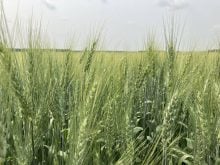Farmers are running into the arms of the big crops this summer and running away from the small acreage crops.
Producers told a Statistics Canada survey in March that they hope to boost their canola acreage to 19.23 million acres, up 18.7 percent from 2009, and increase spring wheat acres by 5.9 percent to 17.98 million.
However, they are planning to slash pea area by 27 percent from 2009, flax by 29.2 percent and barley by 9.6 percent.
Oats, soybeans and grain corn acreage is predicted to rise by eight or nine percent.
Read Also

Why feds imposed EV tariffs
Moe and Kinew have a fight on their hands when it comes to eliminating the EV tariff. Canada has to worry about pissing off the U.S. and Mexico and hundreds of thousands of auto workers.
Many of the increases and decreases are much more dramatic when compared to 2010, but millions of acres were lost to appalling spring seeding conditions last year and most analysts don’t consider it a reasonable comparison.
Summerfallow acres are expected to drop to a record low of 5.08 million acres, which is 18.5 percent less than 2009 and 56.2 percent less than 2010.
Few analysts expressed surprise over how farmers have sorted out the crop winners and losers. The wholesale embrace of spring wheat and canola is the most sensible thing.
“A lot of rotations have been squeezed the last couple of years, so to have a chance to put a cereal in the ground and make money on it is a big deal,” saidWild Oatsnewsletter analyst John Duvenaud.
Agri-Trend marketing manager Derek Squair said farmers are going with the big crops that are easy to seed, grow and market.
“They’re going to go with canola first and wheat second and whatever’s left over to seed after that might see a little surge, like oats and flax.”
Canola is easy to seed in wet conditions and wheat is the easiest to grow of all crops, which is one reason farmers will favour them in challenging spring seeding conditions this year.
However, Squair said marketing concerns are also playing a major role because wheat and canola are in the top end of crop profitability.
“We haven’t seen these kinds of wheat prices for 13 years.”
Canola is also easy to pre-sell and market.
The crops that are losing acreage are trickier to market and have been pushed in recent years.
“You can’t hedge flax. You can’t pre-sell it like you can with canola,” Squair said. “With peas, you can’t get a new crop price today. We’re expecting $8, but you can’t get it today.”
The Statistics Canada report had little direct impact on markets because the numbers were within the range of analysts’ pre-report guesses. Oats may have had the biggest immediate market impact.
Oat acres are expected to be up 8.7 percent from 2009 and 39.3 percent from last year.
However, that’s not a large enough increase to turn the outlook bearish, according to Randy Strychar of Oat-Insight.
“Stop selling,” said Strychar, repeating in an interview words he had written in red in his weekly oat market report.
“That StatsCan number is a nice, pretty number, but that 10 percent increase (from 2009) is the bare minimum we have been calling for all winter. We’re going to get down to an ending stocks number that I think is perilous.”
Squair said his company’s advisers have been encouraging farmers to use the Canadian Wheat Board’s Fixed Price Contract for wheat at any price over $8 per bushel (delive re d, price at elevator), which equates to $9.50-$9.75 in-store Vancouver.
“Anything over eight bucks we’re saying go ahead, do it,” said Squair.
He is also encouraging farmers to lock in canola with cash contracts with a call option for crop they are comfortable they can grow, and use put options to cover crop they aren’t confident they can grow for sure but for which they want downside potential.















